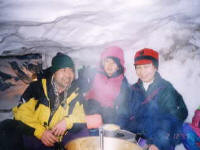Camping and Caravanning
Past, Present and Future of the Camping

Katayuki kanko, siniyuki sinko."
(Packed snow, Cold snow, Crunch and Slip)
In a story of Kenji Miyazawa, Japanese famous writer of fairy tales, children feel refreshed singing that verse in early spring. They can walk over bushes covered with snow as far as they like.
In heavy snow zones in Japan, you can make a camp without a tent. One day in April, if the weather is stable, you can dig a hole in the snow with a scoop for a lodgment. You can even dig a cave for accommodating five persons in one hour if you have a good skill.
However ironical it may sound, it is rather warm in the snow. In Japan the land is not frozen tightly and seldom upheaves. The temperature of a surface of the land won't fall under 0 Celsius.
The warm Japan Stream, like the Gulf Stream in the Pacific Ocean, comes from the equator and meet with the cold air mass which comes from the North Pole. This encounter of the warm seawater in its evaporation with the cold wind above the Japan Sea produces a big mass of the snow cloud. When the snow cloud is brought by the northwest wind against the mountain chains running through the land of Japan, it becomes snow causing heavy snowfalls. This is a reason why we have so much snow in Japan which is located at a pretty low latitude.
Everything you need for making a snow cave, you have learned from the sand box in the kindergarten. Urban children living in a so called concrete jungle enjoy digging in the snow. Sometimes they quarrel and throw snow balls each other with dropping tears. Thus they learn how to solve troubles, conquer a crisis and cooperate with others to reach their target.
A Chinese character representing a snow cave has another meaning; lighting through the paper. At night children talk each other in the snow cave where the snow wall is casting a pale light. It reminds us of a fairly tale saying that wild animals stop to watch into the snow cave.
January 2001(Asia-Pacific News No.6)














